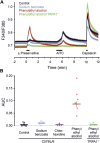TRPA1-dependent and -independent activation by commonly used preservatives
- PMID: 37860113
- PMCID: PMC10582264
- DOI: 10.3389/fphar.2023.1248558
TRPA1-dependent and -independent activation by commonly used preservatives
Abstract
Background and purpose: Addition of preservatives ensures microbial stability, especially in multidose containers of parenterally administered pharmaceuticals. These compounds can cause side effects, and particularly at the site of application, might elicit or facilitate pain. TRPA1 is a cation channel expressed in peripheral neurons which contributes to pain and inflammation and is sensitive to many irritants. The most commonly used preservatives, in particular with a focus on parenteral formulations, were investigated for their potential to activate TRPA1. Experimental approach: Sixteen preservatives were screened for mediating calcium influx in human TRPA1-transfected HEK293t cells. Untransfected cells served as control, results were further validated in mouse sensory neurons. In addition, proinflammatory mediators serotonin, histamine and prostaglandin E2 were co-administered to probe a potential sensitisation of preservative-induced TRPA1 activation. Key results: Butylparaben, propylparaben, ethylparaben, bronopol, methylparaben, phenylethyl alcohol and phenol induced a TRPA1-dependent calcium influx in transfected HEK293t cells at concentrations used for preservation. Other preservatives increased calcium within the used concentration ranges, but to a similar degree in untransfected controls. Serotonin, histamine, and prostaglandin enhanced TRPA1 activation of phenylethyl alcohol, bronopol, ethylparaben, propylparaben and butylparaben. Conclusion and implications: Systematic screening of common preservatives applied for parenterally administered drugs resulted in identifying several preservatives with substantial TRPA1 channel activation. This activation was enhanced by the addition of proinflammatory meditators. This allows selecting a preservative without TRPA1 activation, particularly in case of pharmaceuticals that could act proinflammatory.
Keywords: TRP channel; TRPA1; inflammation; pain; parenteral; preservative; sensitisation.
Copyright © 2023 Mager, Ciotu, Gold-Binder, Heber and Fischer.
Conflict of interest statement
The authors declare that the research was conducted in the absence of any commercial or financial relationships that could be construed as a potential conflict of interest.
Figures




Similar articles
-
Final amended report on the safety assessment of Methylparaben, Ethylparaben, Propylparaben, Isopropylparaben, Butylparaben, Isobutylparaben, and Benzylparaben as used in cosmetic products.Int J Toxicol. 2008;27 Suppl 4:1-82. doi: 10.1080/10915810802548359. Int J Toxicol. 2008. PMID: 19101832
-
Agonist-induced sensitisation of the irritant receptor ion channel TRPA1.J Physiol. 2016 Nov 15;594(22):6643-6660. doi: 10.1113/JP272237. Epub 2016 Aug 4. J Physiol. 2016. PMID: 27307078 Free PMC article.
-
Etomidate and propylene glycol activate nociceptive TRP ion channels.Mol Pain. 2018 Jan-Dec;14:1744806918811699. doi: 10.1177/1744806918811699. Epub 2018 Oct 22. Mol Pain. 2018. PMID: 30345869 Free PMC article.
-
Antimicrobial Preservatives for Protein and Peptide Formulations: An Overview.Pharmaceutics. 2023 Feb 7;15(2):563. doi: 10.3390/pharmaceutics15020563. Pharmaceutics. 2023. PMID: 36839885 Free PMC article. Review.
-
Antimicrobial preservative use in parenteral products: past and present.J Pharm Sci. 2007 Dec;96(12):3155-67. doi: 10.1002/jps.20976. J Pharm Sci. 2007. PMID: 17722087 Review.
References
-
- Bahia P. K., Parks T. A., Stanford K. R., Mitchell D. A., Varma S., Stevens S. M., Jr., et al. (2016). The exceptionally high reactivity of Cys 621 is critical for electrophilic activation of the sensory nerve ion channel TRPA1. J. Gen. Physiol. 147 (6), 451–465. 10.1085/jgp.201611581 - DOI - PMC - PubMed
LinkOut - more resources
Full Text Sources
Molecular Biology Databases

